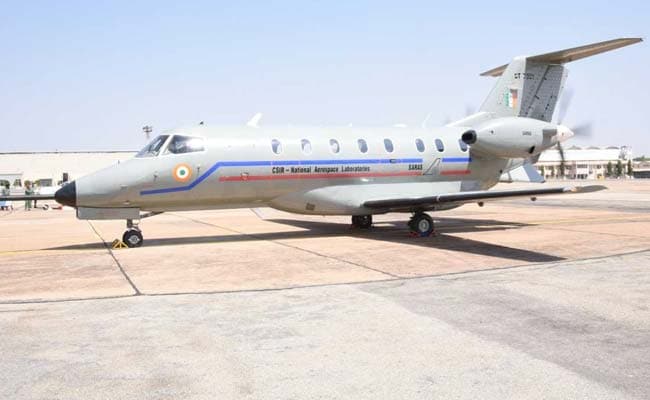Asia
A closer look at “Saras”, India’s first home-made passenger plane

A closer look at “Saras”, India’s first home-made passenger plane : Saras, a 19-seater turboprop aircraft is the country’s first passenger and transport plane. Bengaluru-based National Aerospace Laboratory (NAL) has designed the aircraft. According to the reports, the passenger plane will have multi-role capabilities like feeder line aircraft, air ambulance, executive aircraft, troop transport, reconnaissance, aerial survey and light cargo transport. NAL Director Jitendra J Jadhav speaking to a National Media Channel said the engine tests have already begun and test flights were successfully contrived this year.
The project was resurrected in 2016. The 7,000-kg plane has already made two successful test flights this year.
It would cost Rs 1,000 crore before production starts in 2022. But that’s still a saving compared to what India currently pays. Saras is expected to cost Rs 45 crore, while a comparable Dornier plane costs Rs 60 crore.
Hindustan Aeronautics Limited (HAL) has been identified as the production agency for the military version of Saras, while the production of civil version will be given to a private player, NAL says. India needs 120-160 aircraft in this segment — both civil and military versions — in the next 10 years.

According to NAL, the aircraft available in the international market are of 1970s technology, such as Beechcraft 19000D, Dornier-228 and Embraer EMB 110. They have higher fuel consumption, lower speed, unpressurised cabin, high operating cost and unsuitable for operations from hot and high-altitude airfields.
“India needs a 19-seater aircraft. We are planning to make a plane with 2018 technology but 30 per cent cheaper than imported aircraft. It will also have 20 per cent better performance than imported aircraft,” the NAL director said.
Courtesy : NDTV

Asia
Singapore Airlines emergency landing after severe turbulence

One passenger passed on, while dozens of passengers were injured when a Singapore Airlines Boeing B777-300ER aircraft experienced severe turbulence while en route to Singapore from London Heathrow Airport. The aircraft diverted to Bangkok, and landed at 3:45pm Local time on 21 May 2024
The flight landed with 211 Passengers and 11 Crew members at Bangkok Suvarnabhumi Airport. According to the Airport Director Kittipong Kittikachorn at a news conference, there were 7 passengers who suffered serious injuries, while a number of other passengers suffered injuries of varying seriousness.
It was also confirmed that the passenger who passed on was a 73 year old British Man. In a statement from Singapore Airlines ‘ As of 0505 hours Singapore Time on 22 May 2024, 79 passengers and 6 crew members from SQ321 remain in Bangkok’. In another statement, it was reported that a relief flight with 143 passengers and crew members arrived in Singapore at 0505 hours Singapore time on 22 May 2024.
According to aircraft tracking site FlightRadar24, the 16 Year Old Boeing B777-300ER aircraft descended sharply from 37,000 feet to 31,000 feet in a short time. It was also further reported by FlightRadar24 that the descent was commanded by Autopilot, instead of being caused by turbulence.
Shortly afterwards, the pilot declared an emergency by squeaking 7700 on the transponder, indicating an emergency situation onboard the aircraft. The Boeing 777 aircraft then diverted to Bangkok, instead of continuing on its planned journey to Singapore.
In view of this incident, Singapore Airlines mentioned in a statement that they are working with the relevant authorities on the investigation into this incident.
The National Transportation Safety Board, a US Government investigative agency for civil aviation incidents, is sending an accredited representative and 4 technical advisors to support the investigation by Singapore’s Transport Safety Investigation Bureau (TSIB). TSIB mentioned in a statement that it ‘is in touch with its Thai counterparts and will be deploying investigators to Bangkok’.
Boeing, the manufacturer of the Boeing B777 aircraft mentioned in a statement that they are in contact with Singapore Airlines regarding the ill-fated flight, and ‘stand ready to support them’.
This situation is developing, more details will be added when they become available.
-

 Travel1 week ago
Travel1 week agoAir India to Expand US Operations with Three New Routes After a Decade
-

 Travel2 weeks ago
Travel2 weeks agoWhy We Should Avoid These Stamps in a Passport
-

 Airlines1 month ago
Airlines1 month agoInvestigations Reveal Fake Chinese Titanium in Boeing and Airbus Jets
-

 Tech4 weeks ago
Tech4 weeks agoChina’s CATL Plans 1,800-Mile Electric Plane Launch by 2027
-

 Airport3 days ago
Airport3 days agoTop 10 Largest Airports in the World by Size
-

 Aerospace4 weeks ago
Aerospace4 weeks agoChina’s Fighter Jets Turn Wings into Autonomous Drones
-

 Airlines4 days ago
Airlines4 days agoAir India Rolls Out A350s for Delhi-New York JFK and Newark Routes
-

 Defence3 weeks ago
Defence3 weeks agoBoeing Enhances Chinook with New Engines and Block II Upgrades at $96 Million







